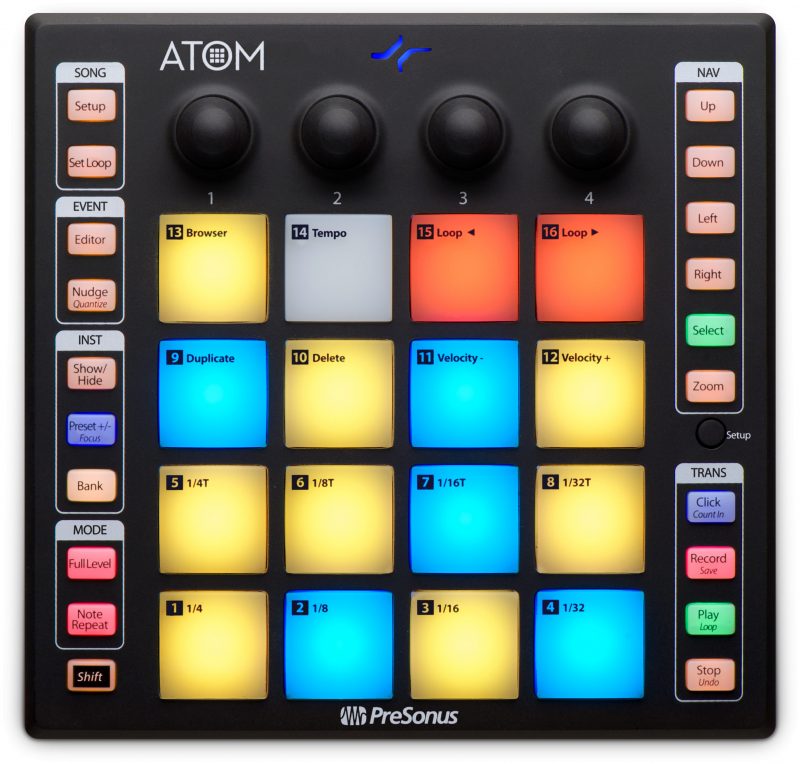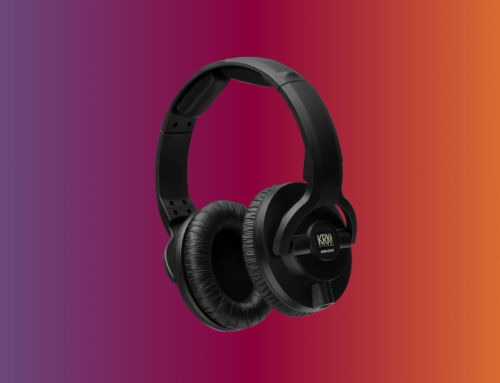The PreSonus ATOM is the first pad controller released by PreSonus, and as you might expect, it is designed to natively synchronize with the brand’s “Studio One” production and performance software. Whether you use this software or not, the ATOM is an attractive prospect as a pad controller for virtual instruments and other DAWs, especially when you consider the price tag. The small (just under 8-inch x 8-inch) and brightly colored surface certainly looks impressive and draws you to this piece of equipment. Does the PreSonus ATOM live up to expectations?
Features
The ATOM is designed to be your trusty assistant whether you are using it in a live or a studio environment. It should be said right at the start that this works best with Studio One, luckily, this software is included with the controller, so there’s no extra expense there. If you are dead set on using another DAW then it can be configured for others, but for full plug-and-play integration, you’re going to need Studio One. The software can do what most others can, and is suitable for production, recording and live use.
The features include 16 pads which are both pressure and velocity sensitive. These can be used within eight pad banks, which can be switched between. This means you can easily assign a drum rack to a pad bank and switch mid-song should you need to. 20 assignable buttons are mapped within Studio One, but you can set them to control different things within different software.
As well as triggering individual samples from the pads for recording in MIDI or performance, you can set them to trigger loops and build a whole soundscape and full mix of a track without having to reach for the laptop.
There are also four rotating knobs which can be set up to control parameters within your DAW or within virtual instruments. These won’t be set automatically, so be prepared to do some mapping. Four knobs are not the highest number you can get in a controller this size and is one of the few areas that could arguably be improved.
The transport controls are located on the right of the PreSonus ATOM, and the basic controls are extremely simple. Things like record, pause and play as well as metronome can be used with ease. There are loads more controls though, and the brand’s marketing material claims you can control everything in software without having to leave the transport control. You can add tracks, browse instruments, alter the tempo and select loops and samples using this. It takes a while to learn it all but in the long run, it may well be worth it. All of this works brilliantly with Studio One without having to do too much in the way of mapping. If you’re a Logic or ProTools user, be prepared to do some fiddling and messing around to get the right controls.

Modes
The native mode that the ATOM loads up in is suitable mainly for triggering samples such as from a virtual drum machine. This mode utilizes the sensitivity of the pads to allow you to add real subtlety and nuance to your beats whether you are replicating an acoustic drum kit or making an electronic beat. A ‘note repeat’ function means that when you hold down the pad it will trigger the note on a loop, great for hi-hat patterns.
There is a “Keyboard” mode too. Many pad controllers offer this now, and it is a great alternative to having to take a MIDI keyboard if you are producing on the go or even a way to trigger synth sounds live. The piano keys are represented by yellow and blue instead of white and black. You have one octave to play with on the pads, but you can easily switch the octave up or down.
The ATOM allows you to press shift and “Preset +/ Focus” on the controller to trigger something called Pad Focus. This mode lets you have even more control over sounds with things like the Cutoff and Resonance on synths being controlled along with the pitch and gain of certain sounds.

Value for Money
At the price tag, there aren’t many competing MIDI controllers with such sensitive and high-quality light up pads. When you consider that the software which is included costs $100 anyway, you’ll see that there is value to be had here.
Who is it For?
The PreSonus ATOM is a great first pad controller for producers and is a wonderful choice if you are using Studio One, or don’t mind converting. To get the full impact of this controller, using the PreSonus software is recommended. The fact that this is USB powered and has a MIDI keyboard mode makes it a good choice for pretty much anyone looking to produce music when out-and-about. It is a great rucksack tool for producers.
Conclusion
The PreSonus ATOM is certainly something we are happy to recommend for both studio use and live performance. It is a surprisingly powerful piece of equipment at a good price. If you are happy to map this to the software you use, you can truly embrace everything this can do, and streamline your music production workflow. The four assignable knobs could perhaps do with doubling to eight, but generally speaking, there are virtually limitless options for manipulating and playing sounds. Eight pad banks is plenty, and the transport controls are something you will be especially thankful for if already using Studio One. The integration with PreSonus’ own software is, as you might expect, impressive.




